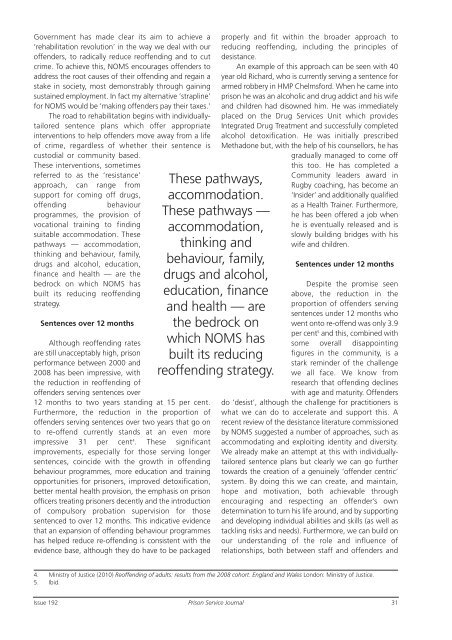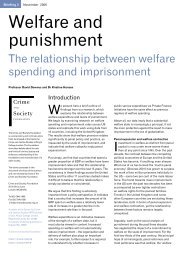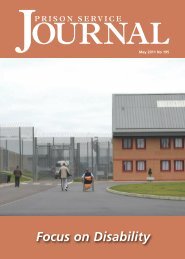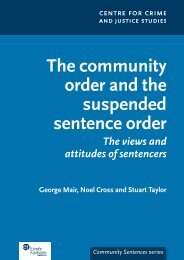PRISON SERVICE
PRISON SERVICE
PRISON SERVICE
- No tags were found...
You also want an ePaper? Increase the reach of your titles
YUMPU automatically turns print PDFs into web optimized ePapers that Google loves.
Government has made clear its aim to achieve a‘rehabilitation revolution’ in the way we deal with ouroffenders, to radically reduce reoffending and to cutcrime. To achieve this, NOMS encourages offenders toaddress the root causes of their offending and regain astake in society, most demonstrably through gainingsustained employment. In fact my alternative ‘strapline’for NOMS would be ‘making offenders pay their taxes.’The road to rehabilitation begins with individuallytailoredsentence plans which offer appropriateinterventions to help offenders move away from a lifeof crime, regardless of whether their sentence iscustodial or community based.These interventions, sometimesreferred to as the ‘resistance’approach, can range fromsupport for coming off drugs,offendingbehaviourprogrammes, the provision ofvocational training to findingsuitable accommodation. Thesepathways — accommodation,thinking and behaviour, family,drugs and alcohol, education,finance and health — are thebedrock on which NOMS hasbuilt its reducing reoffendingstrategy.Sentences over 12 monthsAlthough reoffending ratesare still unacceptably high, prisonperformance between 2000 and2008 has been impressive, withthe reduction in reoffending ofoffenders serving sentences over12 months to two years standing at 15 per cent.Furthermore, the reduction in the proportion ofoffenders serving sentences over two years that go onto re-offend currently stands at an even moreimpressive 31 per cent 4 . These significantimprovements, especially for those serving longersentences, coincide with the growth in offendingbehaviour programmes, more education and trainingopportunities for prisoners, improved detoxification,better mental health provision, the emphasis on prisonofficers treating prisoners decently and the introductionof compulsory probation supervision for thosesentenced to over 12 months. This indicative evidencethat an expansion of offending behaviour programmeshas helped reduce re-offending is consistent with theevidence base, although they do have to be packagedThese pathways,accommodation.These pathways —accommodation,thinking andbehaviour, family,drugs and alcohol,education, financeand health — arethe bedrock onwhich NOMS hasbuilt its reducingreoffending strategy.properly and fit within the broader approach toreducing reoffending, including the principles ofdesistance.An example of this approach can be seen with 40year old Richard, who is currently serving a sentence forarmed robbery in HMP Chelmsford. When he came intoprison he was an alcoholic and drug addict and his wifeand children had disowned him. He was immediatelyplaced on the Drug Services Unit which providesIntegrated Drug Treatment and successfully completedalcohol detoxification. He was initially prescribedMethadone but, with the help of his counsellors, he hasgradually managed to come offthis too. He has completed aCommunity leaders award inRugby coaching, has become an‘Insider’ and additionally qualifiedas a Health Trainer. Furthermore,he has been offered a job whenhe is eventually released and isslowly building bridges with hiswife and children.Sentences under 12 monthsDespite the promise seenabove, the reduction in theproportion of offenders servingsentences under 12 months whowent onto re-offend was only 3.9per cent 5 and this, combined withsome overall disappointingfigures in the community, is astark reminder of the challengewe all face. We know fromresearch that offending declineswith age and maturity. Offendersdo ‘desist’, although the challenge for practitioners iswhat we can do to accelerate and support this. Arecent review of the desistance literature commissionedby NOMS suggested a number of approaches, such asaccommodating and exploiting identity and diversity.We already make an attempt at this with individuallytailoredsentence plans but clearly we can go furthertowards the creation of a genuinely ‘offender centric’system. By doing this we can create, and maintain,hope and motivation, both achievable throughencouraging and respecting an offender’s owndetermination to turn his life around, and by supportingand developing individual abilities and skills (as well astackling risks and needs). Furthermore, we can build onour understanding of the role and influence ofrelationships, both between staff and offenders and4. Ministry of Justice (2010) Reoffending of adults: results from the 2008 cohort. England and Wales London: Ministry of Justice.5. Ibid.Issue 192 Prison Service Journal31











